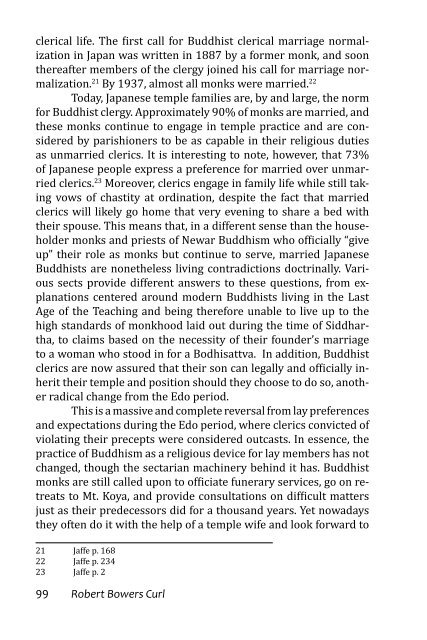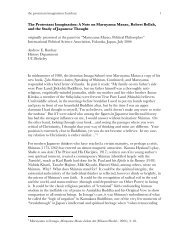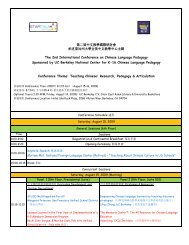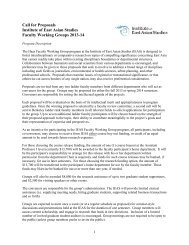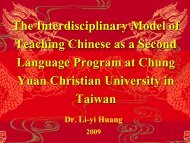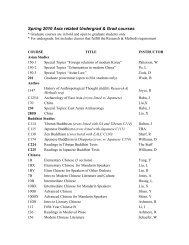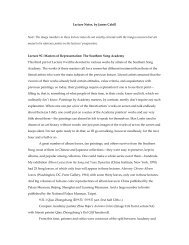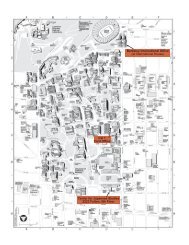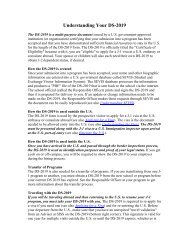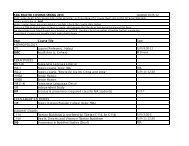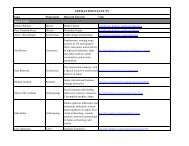Third Edition Spring 2013 - Institute of East Asian Studies, UC ...
Third Edition Spring 2013 - Institute of East Asian Studies, UC ...
Third Edition Spring 2013 - Institute of East Asian Studies, UC ...
Create successful ePaper yourself
Turn your PDF publications into a flip-book with our unique Google optimized e-Paper software.
clerical life. The first call for Buddhist clerical marriage normalizationin Japan was written in 1887 by a former monk, and soonthereafter members <strong>of</strong> the clergy joined his call for marriage normalization.21 By 1937, almost all monks were married. 22Today, Japanese temple families are, by and large, the normfor Buddhist clergy. Approximately 90% <strong>of</strong> monks are married, andthese monks continue to engage in temple practice and are consideredby parishioners to be as capable in their religious dutiesas unmarried clerics. It is interesting to note, however, that 73%<strong>of</strong> Japanese people express a preference for married over unmarriedclerics. 23 Moreover, clerics engage in family life while still takingvows <strong>of</strong> chastity at ordination, despite the fact that marriedclerics will likely go home that very evening to share a bed withtheir spouse. This means that, in a different sense than the householdermonks and priests <strong>of</strong> Newar Buddhism who <strong>of</strong>ficially “giveup” their role as monks but continue to serve, married JapaneseBuddhists are nonetheless living contradictions doctrinally. Varioussects provide different answers to these questions, from explanationscentered around modern Buddhists living in the LastAge <strong>of</strong> the Teaching and being therefore unable to live up to thehigh standards <strong>of</strong> monkhood laid out during the time <strong>of</strong> Siddhartha,to claims based on the necessity <strong>of</strong> their founder’s marriageto a woman who stood in for a Bodhisattva. In addition, Buddhistclerics are now assured that their son can legally and <strong>of</strong>ficially inherittheir temple and position should they choose to do so, anotherradical change from the Edo period.This is a massive and complete reversal from lay preferencesand expectations during the Edo period, where clerics convicted <strong>of</strong>violating their precepts were considered outcasts. In essence, thepractice <strong>of</strong> Buddhism as a religious device for lay members has notchanged, though the sectarian machinery behind it has. Buddhistmonks are still called upon to <strong>of</strong>ficiate funerary services, go on retreatsto Mt. Koya, and provide consultations on difficult mattersjust as their predecessors did for a thousand years. Yet nowadaysthey <strong>of</strong>ten do it with the help <strong>of</strong> a temple wife and look forward to21 Jaffe p. 16822 Jaffe p. 23423 Jaffe p. 2their sons <strong>of</strong>ficially (and legally) inheriting their roles. To reiteratethe two main points <strong>of</strong> our discussion: 1) The Meiji state engagedin a campaign <strong>of</strong> forced laicization, in which the Buddhist clergywere stripped <strong>of</strong> their special legal status and made to registerwith local authorities as commoners or other class <strong>of</strong> layperson. 2)After the campaign <strong>of</strong> forced laicization, the state decriminalizedmeat eating and clerical marriage, which had been punishable bysecular proceedings under the Tokugawa state.ConclusionAt this point several things should have been clear: Japanesemonks are not the only Buddhist monks in Asia to practicemarriage; and there is a clear distinction between the relationship<strong>of</strong> Buddhism to the state in Theravada and Newar traditions; reflectsthe massive shift in the relationship between Japanese Buddhismand the Japanese state in the late 19th century.These three facts make clear that Japanese Buddhism duringthe Edo period enjoyed a relationship with the state resemblingTheravada Buddhism’s relationships with the Sri Lankan and Thaistates, with strong connections between the government and sangha.These relationships resulted in significant secular power andsecular status for the sangha, as well as occasional government interventionto “cleanse” the sangha. Additionally, monks who broketheir precepts were not considered able religious figures by the laity.In contrast, after the Meiji Restoration and its subsequent series<strong>of</strong> laws that amounted to forced laicization, Buddhism transitionedto a model that resembled Newar Buddhism. The links to the stateweakened to the point where it provided little to no protection forthe sangha, breaking down discipline in the sangha, yet withoutan accompanying loss <strong>of</strong> status as figures with religious power. Inthe same way as the householder monks (and more specifically,the householder priests) <strong>of</strong> Newar Buddhism, Japanese monksare free to engage in lay life and continue their role as religiousfigures despite their existence as living doctrinal contradictions.Moreover, their sons are entitled to inherit their temple and clientbase should they chose to, just as in the Newar tradition. To wit, it99 Robert Bowers Curl Laicization in Japanese Buddhism 100


